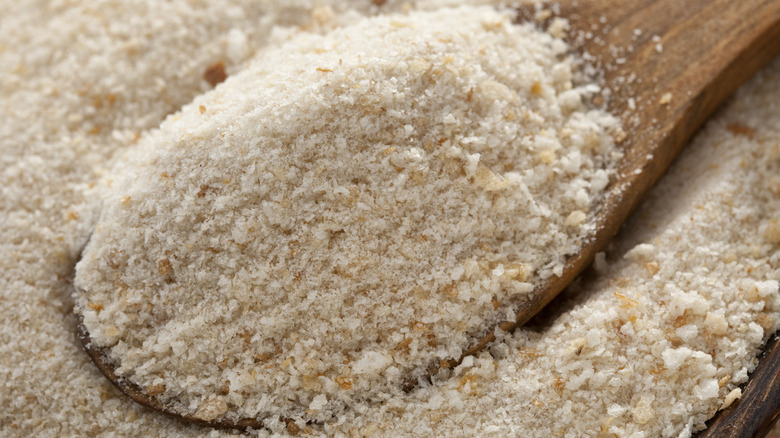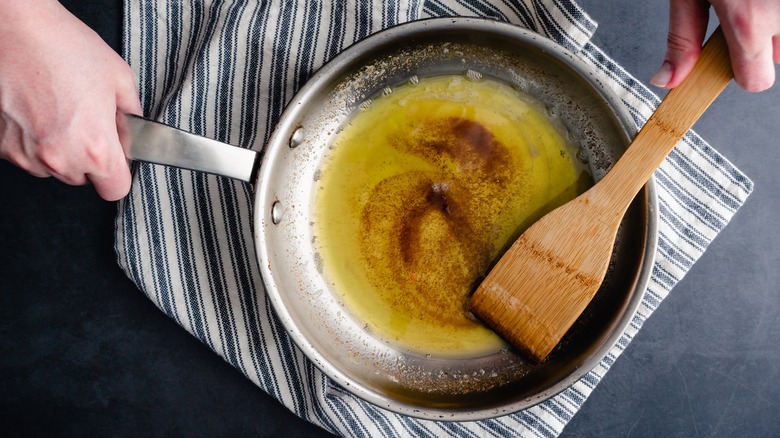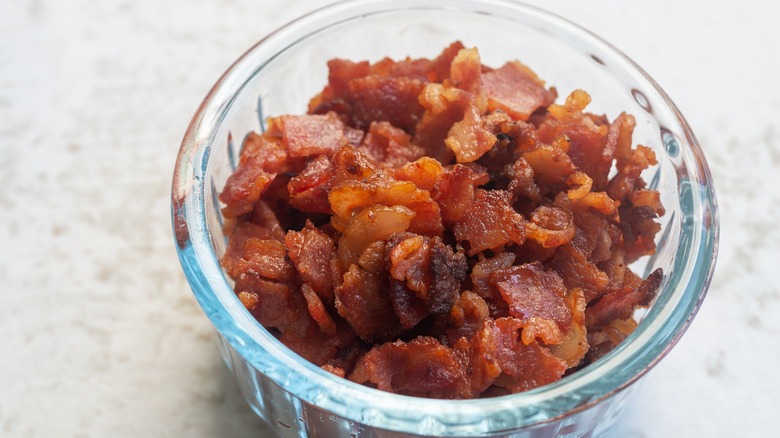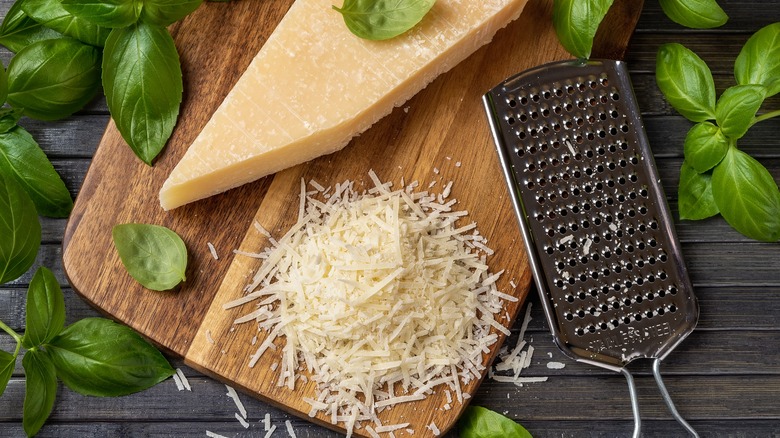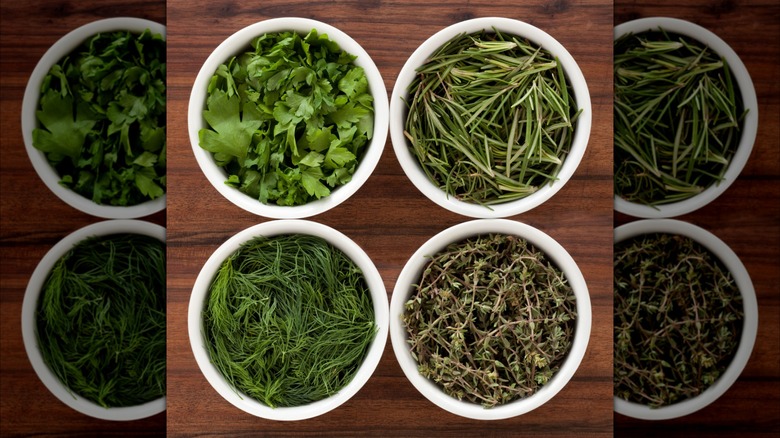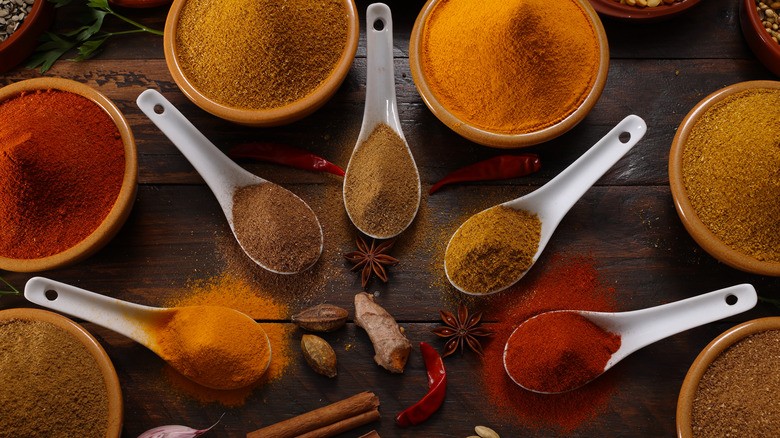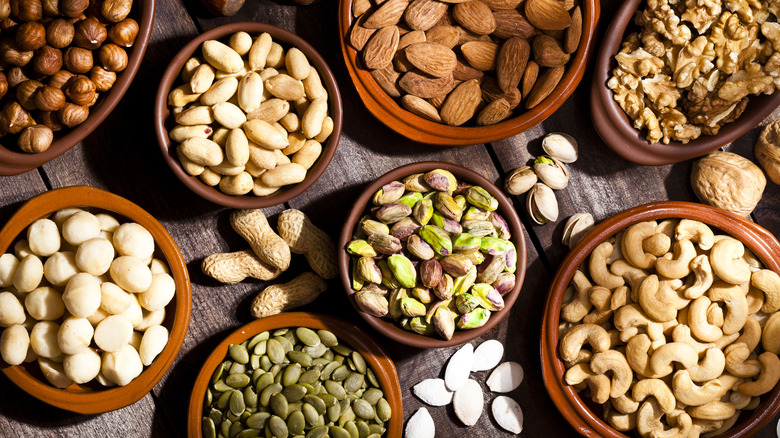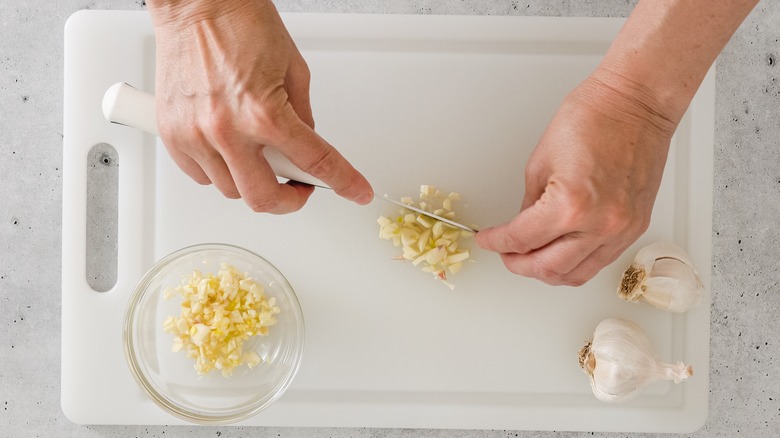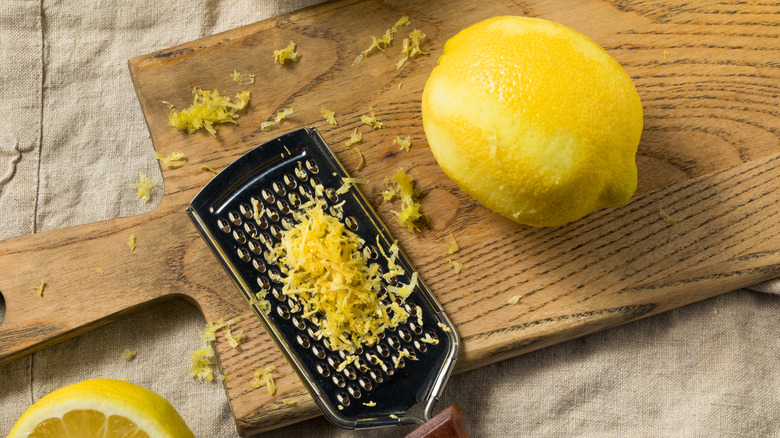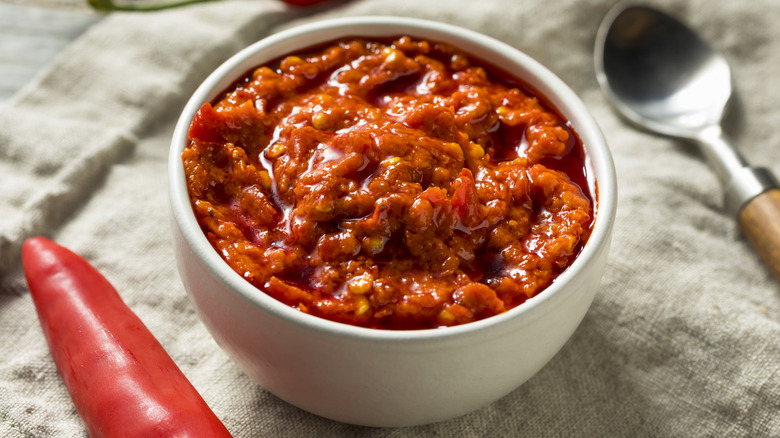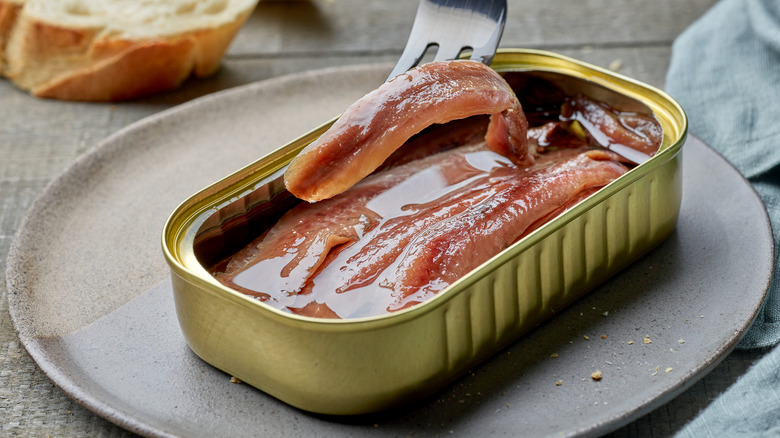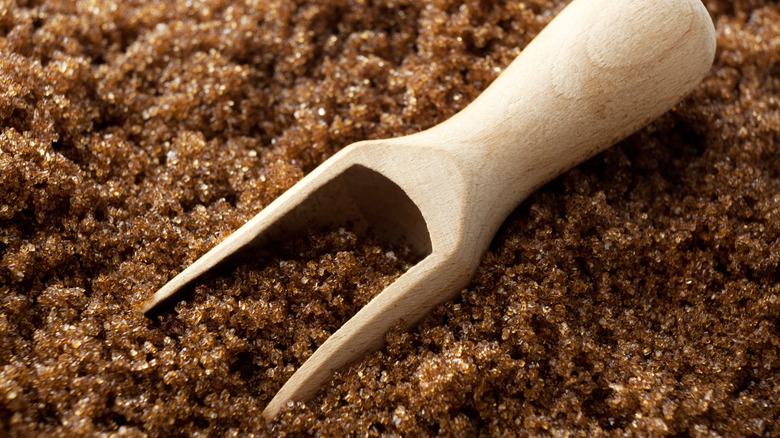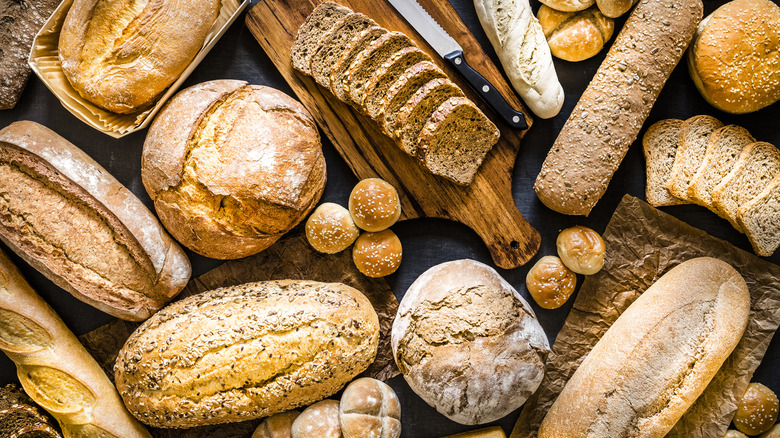12 Ways To Add More Flavor To Bread Crumbs
If you only think of bread crumbs as a binder for meatballs or a coating for cutlets, you're missing out on their greater potential. Of course, sprinkling plain bread crumbs over a dish isn't enough to titillate your taste buds. But considering they're primarily made with bread — an ingredient with endless pairings — it follows that these crispy crumbs can be combined with a wide range of ingredients to add some oomph. With a sprinkling of herbs, spices, and crunchy flavorful add-ins, this pantry staple will be quickly transformed.
Once you start seasoning ordinary bread crumbs, it's unlikely you'll ever go back. After all, you might not think about spooning crumbs from the container straight over a plate of pasta ... but what about parmesan garlic crumbs? You can customize the add-ins for your palate and dietary preferences to ensure the result is exactly as you desire, and there's plenty of room to experiment with the type of loaf you use if you choose to make bread crumbs from scratch.
We've collected our favorite ideas for adding flavor to bread crumbs so you can use them to enhance your dishes. With this assortment, you'll be thinking of more ways to add a crispy finish to your favorite meals — both savory and sweet. Whether it's a homemade variety or your standard, run-of-the-mill item from the store, here are 12 ways to add more flavor to bread crumbs.
Toast them in fat
Oftentimes, the way to infuse more flavor into a recipe is by adding a source of fat. Whether you prefer cooking with butter, olive oil, or an alternative, fat is key to transporting flavor. Now, you don't have to drown your bread crumbs. But coating them in a fatty base helps bring out the subtle flavors in the bread.
Simple toasted crumbs add a crunchy bite to casseroles or a plate of spaghetti. As a coating, they'll immediately enhance the flavor of whatever is beneath with minimal effort. If you plan on using additional spices or herbs, a buttery backdrop will help the seasonings meld with the crumbs. Or add layers of flavor in one simple step by using an infused oil; garlic, chili, herb, or truffle are a few popular options that will instantly elevate basic crumbs.
You can achieve perfectly toasted bread crumbs in a skillet or the oven. If you're opting for the former, simply heat olive oil or melt butter in a pan and add the crumbs directly. For the oven, start by tossing the crumbs with your preferred oil or melted butter. Then, spread them out on a baking sheet and toast until golden. Just remember: The transition to black and burnt can be quick, so be sure to keep an eye on the tray.
Add crunchy bacon bits
If you believe bacon makes everything taste better, you'll want to test that theory with bread crumbs. Spoiler: It's true. Now, if you're looking for the most direct path to bacon bread crumbs, you can always use store-bought bacon bits (though most don't contain any actual bacon). For a more flavorful option — one that retains the iconic pork taste — chop bacon strips and pan-fry them until they reach your desired crispiness.
If you're looking for a chunkier bacon add-in, you can keep the pieces on the larger side. Otherwise, finely chop the meat to ensure it blends seamlessly with the crumbs. You can toast the crumbs with the bacon directly in the skillet or combine them in a bowl and toast them in the oven for an extra crunchy seasoning. If you want to add another layer of flavor, garlic powder or minced garlic pair wonderfully.
This salty combo is the ultimate topper for mac and cheese or a green bean casserole. It also works well with a simple pasta dish, roasted Brussels sprouts, mixed with broccoli, or as a replacement for croutons and bacon bits on a salad. For a truly delightful twist, sprinkle it over a cheeseburger for a crispy surprise.
Grate some cheese
Adding cheese to a savory dish can instantly lift it to gourmet heights. Since bread crumbs are no exception, give them an injection of flavor with this one basic ingredient. Now, several types of cheese can be used for this purpose, but you'll want to consider whether you prefer a hard cheese that doesn't melt as readily or a less firm option that becomes gooey. Either way, just mix the crumbs and cheese along with any other add-ins (such as olive oil or fresh chopped herbs).
Many savory recipes can benefit from this addition, and parmesan is a good place to start. The hard cheese grates into a fine consistency that blends seamlessly with breadcrumbs. Use it (or similar options like grana or pecorino) with fine-to-coarse crumbs or panko for a salty umami kick to your meal. This combo is a no-brainer to sprinkle over pasta, but try it in salads and casseroles, as well. Meanwhile, smoked gouda makes a fantastic pairing to add to a mac and cheese, or as a potato gratin crumb topping.
Sprinkle in fresh herbs
Adding fresh herbs as a finishing touch is an automatic way to boost the flavor of any dish, so why not include them in your bread crumbs? The combination provides a crunchy texture and flavorful infusion in one easy add-on – particularly when you're already planning to use fresh herbs as a garnish.
The simplest option involves chopping your herbs of choice before pulsing them in a food processor with the crumbs, which allows the flavors to fully meld together. If you prefer toasted crumbs, brown them according to your preferred method (in a skillet or oven), then stir in any finely chopped herbs. Be sure to add the herbs once the heat is off, though, so they don't wilt.
Choose the particular herbs depending on the profile of your recipe. For example, parsley or basil work well in Italian-inspired dishes, while thyme, rosemary, and tarragon nicely complement French cuisine. You can also use chives as a zingy garnish to add a hint of onion. Plus, if you store your herb breadcrumbs in a sealed container in the fridge, they will keep for around a week — giving you multiple opportunities to sprinkle them over your dishes.
Season with dried herbs or spices
Fresh herbs are great, but it can be hard to keep them at their peak. Thankfully, dried herbs and spices make an excellent substitute — one that's available at any time. More than that, bread crumbs seasoned with dried herbs and spices are more shelf-stable than those mixed with fresh herbs and can last up to a year if you store them in an airtight container.
For the easiest option, keep it straightforward and use premade spice mixes. Your choice of seasonings will vary based on your style of cooking, of course, but we suggest keeping Italian bread crumbs in your pantry at all times. Combine several dried herbs (parsley, basil, oregano, thyme, and rosemary) with garlic powder, salt, and bread crumbs, then toast the mixture or keep it as is. Sprinkle it over a bowl of pasta, use it to make a crunchy topping on your next batch of homemade lasagna, or coat chicken breasts in your Italian-seasoned bread crumbs to pack in the flavor.
Meanwhile, you can recreate a similar effect with herbs de Provence – a French blend that includes herbs like marjoram, savory, thyme, rosemary, oregano, tarragon, basil, and mint. Smoked paprika is a simple option that's guaranteed to enhance your bread crumbs, as are Cajun spice mixes, dry meat rubs, or Indian blends like garam masala.
Mix in chopped nuts or seeds
Part of improving the flavor of a dish lies in surprising the palate with textural variations. Using bread crumbs as a garnish already plays on this notion, especially if you opt for extra crispy panko or coarsely chopped crumbs. Of course, you can always further emphasize this aspect by incorporating chopped nuts or seeds, as well. Match the nuts to your dish for a delicious addition with minimal effort. Depending on your preference, choose between toasted or raw and salted or unsalted nuts.
Aside from elevating the crunch factor, these ingredients bring nutty, earthy, and even sweet flavors to the table. The key to integrating nuts or seeds lies in keeping the size small enough so the pieces easily blend with the bread crumbs rather than crushing them into fine dust.
Walnuts pair nicely with panko, parmesan cheese, and thyme to make a crumble topping for a Brussels sprouts gratin recipe. You can even try adding nuts to a bread crumb coating (nothing is stopping you, after all). For this purpose, be sure to pulse the mixture finely in a food processor to ensure it sticks to the surface. Try an easy pecan-crusted trout recipe – you'll be sure to repeat this method over and over once you do.
Add garlic
For a small addition that will make a big difference, garlic is the answer. You can keep the prep super simple and add garlic powder to toasted or untoasted bread crumbs. But when you want to enhance the sweet, earthy notes, reach for fresh garlic cloves. Depending on the intensity you're looking for, you can mince, slice, or crush the cloves before adding them to your crumb mixture.
If you saute the allium for longer, you'll end up with crispy flavor bombs in each bite, whereas a shorter duration in the pan will keep the garlic more tender. Alternatively, try smashing whole garlic cloves and sauteing them with oil, then toast the crumbs in the same pan. Remove the whole cloves before serving to infuse only the fragrance, or leave them in for a surprising burst of flavor.
The ingredient is a classic match for fresh herbs or parmesan cheese to enhance your favorite Italian dish. Improve a simple tomato pasta by sprinkling these flavor-packed crumbs over the top. Use them to add texture to a slice of cheese pizza or a bowl of mac and cheese, or toss them with roasted vegetables or salad greens for a punch of flavor.
Infuse fragrance with citrus zest
The sweet perfume of citrus zest is delicate yet notable enough to transform an ordinary dish into a gourmet meal. Consequently, you should consider grating orange, lemon, or lime zest into your bread crumbs for an easy garnish that immediately brightens up each bite.
Combine the citrus with herbs or spices, such as a classic lemon and pepper duo, or alternatives like lemon and sage, lemon and basil, or lemon and thyme. Meanwhile, lime pairs well with chili, coconut, or cilantro — adding a refreshing touch to your dishes — while orange zest is more tame and makes a good match for sweeter bread crumbs (think challah or brioche).
Use more savory pairings to coat chicken or fish, then fry or bake the cutlets to a golden crisp. Combinations like orange and cinnamon or lime and coconut work nicely in sweet recipes; you can stir these seasoned bread crumbs into a crumble topping or sprinkle them over muffins or a quickbread loaf. You can also use some of the citrus juice to infuse a bit of moisture if necessary, especially if you plan to toast your bread crumbs.
Spice it up
If you can handle a bit of heat, infusing your bread crumbs with a spicy ingredient is a no-brainer. For the most basic method, just mix in chili flakes and sprinkle the mixture over your dish. You can also chop whole dried chili peppers and add them to the starchy mix. However, if you want the crumbs to soak up a bit more flavor, a liquid or oil-based chili product is a better option.
Fans of chili crisp will love the extra crunch imparted when combining it with bits of bread. Meanwhile, Calabrian chilis are commonly sold in a jar — chopped and sitting in oil — and can infuse a sweet and smoky note that complements plenty of dishes, particularly tomato-based recipes. For an impressive and easy meal, serve spaghetti aglio e olio with Calabrian bread crumbs.
Alternatively, veer into the territory of Asian cuisine and pair panko crumbs with sriracha or sambal oelek. Use the crumbs to top a plate of noodles or as a garnish for a zesty salad. And if you want to dress up a fried egg, there's nothing like crispy Tabasco bread crumbs to give it that extra pizzazz.
Make it fishy
Anchovies are often the secret ingredient in favorites like a classic Caesar salad. Yet home cooks tend to be intimidated by the prospect of popping open a can of this salty fish and adding a fillet or two to a recipe. Now, we realize they might not be for everyone, but don't knock it until you try it — particularly with bread crumbs.
If you can't bring yourself to go for whole anchovies, at the very least try this rendition with anchovy paste. The ingredient is super easy to use (it typically comes in a tube) and once it dissolves and blends in with other ingredients, you'll forget about the fish and only taste the rich umami notes. If you're using whole fillets, saute them first in a skillet as you mash them up (into a paste, essentially). Then toss in the bread crumbs until they turn golden, and stir everything together to combine.
Similarly, you can squeeze anchovy paste into a pan with oil and saute the bread crumbs. Garlic and parsley also pair well with anchovies, and the seasoning works wonders when sprinkled over a simple tomato pasta dish. Of course, you can always stick to a familiar pairing, and serve these bread crumbs with Caesar salad.
Sweeten it up
While you might be accustomed to using bread crumbs in savory dishes, there's no reason you should avoid incorporating them into your desserts. A crunchy topping is a delicious garnish for numerous sweet treats — whether a dessert traditionally includes it or not. Sugar and butter do wonders, but a dusting of ground cinnamon is an excellent touch, too.
Think of them as a variation on granola and incorporate sweet bread crumbs into a fruit and yogurt parfait. Add extra layers of texture to a fruit crumble by incorporating coarse bread crumbs into the sugar and butter mixture. You can use most types of bread for this purpose, but challah or brioche pair especially well.
On the flip side, try adding caramelized bread crumbs to an unexpected dessert. Whip them up by melting butter with brown and white sugar, then tossing the sweet mixture with your crumbs. Or use it to add a crispy garnish to a chocolate mousse, pudding, or ice cream sundae.
Use various types of bread
We've alluded to the use of various types of bread in specific recipes, but it's worth emphasizing just how much this can affect the taste and texture of bread crumbs. If you're using a light and airy loaf of white bread, the result will be equally delicate. On the other hand, breads made with darker flours (like pumpernickel or rye) are much denser and offer more complex flavors to match. Sweeter options like brioche, challah, or milk bread can easily be used in either sweet or savory recipes.
Of course, you'll want to adjust your seasonings accordingly if you're opting for bread made with heartier flour. For example, the strong taste of pumpernickel stands up well to garlic (which has sufficiently pungent aromas to pair with rye crumbs), while they can be softened by toasting them in butter.
If you find yourself with leftover flavored bread, be sure to experiment with it as an easy cooking shortcut pre-packed with flavor. Bread crumbs made with cinnamon raisin bread are the perfect topping for a sweet treat, while stale garlic or cheese bread is ready to grind up and sprinkle.
